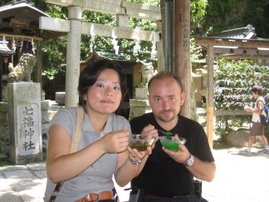My first trip to Japan began in the autumn, so some of my earliest memories are of frigid evenings and the foods that go with them. The Japanese tradition of nabe-ryori or "pot cooking" covers a wide variety of stock based soups and stews. The kitchen menu of most Japanese restaurants in the states will include staples like nabeyaki udon, a rich soup of vegetables and thick noodles. I've even seen some places that make shabu shabu, a soup cooked at the table in a large nabe pot and featuring raw ingredients (meat, veggies, tofu, etc.) that the diners place in boiling stock and cook to their own desired doneness. Less frequently seen on menus here is oden, a braised vegetable dish that is often served in sake bars and from streetside rolling carts on cold winter nights. For some reason I've had oden on my mind these last few days so I decided it would be a good way to inaugurate the season.

Oden can consist of many ingredients, but one thing that it must contain is daikon radish. In addition, for tonight's dinner I included shiitake mushrooms, potato, carrot, two types of fish cakes (kamaboko & chikuwa), konnyaku (yam cake), peeled hard boiled eggs and cubes of deep fried tofu.

The first step is to create the braising liquid. I have several clay nabe pots, but none are big enough for this dish. Instead I used a stainless steel Korean braising pot, into which I placed a square of konbu kelp and water. As the pot came to a boil, I added two teaspoons of instant dashi powder and seasoned to taste with the Japanese trinity (equal parts of soy sauce, sake, and mirin).

All of the ingredients were cut into bite sized pieces and added to the broth. The pot was returned to a boil, covered and the heat reduced to a simmer. I cooked the dish for about 90 minutes, until everything was very tender.

Spoon the ingredients into serving bowls, along with a little of the stock. Japanese like to add a little spicy Chinese-style mustard to each bite, and drink sake with their oden. Sounds like a great way to warm the body on a cold evening doesn't it?


13 comments:
Mmm, that looks good and easy to make. How are the fish cakes? I've seen them (the lump of white and pinkish stuff on the block of wood - right?) but haven't ever tried it. What kind of flavor does it have? (besides "fish". Is it strong, mild, "tastes like chicken" ?)
Where does one purchase / how does one prepare said fishcakes?
Thanks,
Frank
Head Chef
Arena Diner, Hackensack, NJ
You should be able to find fishcakes in any market that has a decent Asian section. It would be in a refrigerated or frozen section.
I miss the Arena Diner....
Especially around 2 am when I want some eggs and hashbrowns.
Hashbrown fishcakes . . . .mmmmmmm.
The flavor is very mild. Similar to the fake crab meat they use in California rolls. Basically a slightly fishy version of cooked egg whites. I know that doesn't sound good, but in this dish it works, I swear!!! The key to this dish is a cold, damp evening. Put on a nice warm sweater, warm up a little sake and serve. It's that perfect, "chase away the chill" sort of dish...
The fishcake doesn't fall apart if you simmer it for 90 minutes?
The fish cakes have egg whites in them, so they hold together well when you simmer them. The texture is a little rubbery, but it works. If you go to your local Asian market ask for Kamaboko (half moon shaped log, pink on the outside, white center on a wood block) and Chikuwa (hollow tube, grilled on the outside, supposed to look like a piece of bamboo).
ok, sorry to "grill" you on this, but doesn't the potato turn to mush after 90 minutes? Did you really put all the ingredients in at the same time? Including the whole boiled egg? I just want to be sure because I really want to try this and I'd like to get it right the first time.
Wait a second.... Dave Rivkin? Didn't Kim buy your blue Thunderbird years ago? or was that someone else?? Jon - can you help me out with the memory thing? I know it was one of your friends car.
Yes that's the same Dave Rivkin that Kim bought the car from.
The potato will get very soft, but if you pick a slightly waxy style potato like a Yukon Gold it will not totally fall apart.
Everything can go in at the same time. The veggies are meant to be very soft, and the fish cakes and hard boiled egg (peeled of course) have egg white protein that stays very tight from the heat so they don't fall apart. Let me know how it comes out!
What kind of flavors does the daikon and konnyaku have? I've seen both many times on Iron Chef, but I haven't had the nerve to pick them up at the store. Are they strong? mild? I've got to try and "sell" this dish to the family and there's an awful lot of stuff they've never tried in there.
Konnyaku is made from a relative of the potato, so it's very neutral.
Do you know the stringy white garnish that they put on the plates in sushi restaurants? that's daikon, a type of radish. it can be a little sharp when served raw, but it's pretty mild when cooked. sort of like a turnip but nowhere near as strong.
You could make this as a side dish with some teriyaki chicken and a salad as a way to introduce the family to the flavor and see if they like it.
Wow, a twelve comment thread! Not bad, Weed-Whacker!
Post a Comment